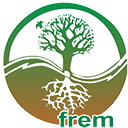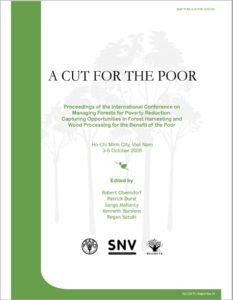Comparing statistical and deep learning approaches for simultaneous prediction of stand-level above- and belowground biomass in tropical forests
Science of the Total Environment, 958 (2025) 177869. https://doi.org/10.1016/j.scitotenv.2024.177869
Huy, B., Poudel, K.P., Temesgen, H., Salas-Eljatib, C., Truong, N.Q., and Khiem, N.Q.
Abstract: Accurate and cost-effective prediction of aboveground biomass (AGB), belowground biomass (BGB), and the total (ABGB) at stand-level within tropical forests is crucial for effective forest ecological management and the provision of forest ecosystem services. Although there has been research on simultaneously fitting biomass equations for tree components, rather fe w studies focus on simultaneously predicting AGB and BGB at stand-level while maintaining additivity. We developed innovative Deep Learning Additive Models (DLAMs) for the simultaneous predictions of stand-level AGB, BGB, and ABGB integrating forest stand, ecological, and environmental factors as predictive covariates and compared them with conventional weighted nonlinear seemingly unrelated regression (WNSUR) and multivariate adaptive regression splines (MARS). Data for this study were collected from 121 plots distributed in two tropical forest types (dipterocarp and evergreen broadleaf) across five ecological regions of Vietnam, capturing three response variables (AGB, BGB, and ABGB), and 12 predictors. Factor analysis for mixed data was employed to identify the optimal covariates. Cross-validation results demonstrated that DLAMs substantially enhanced the reliability of simultaneous predictions of forest biomass components compared to the conventional WNSUR and MARS methods. The optimal DLAMs included seven predictive covariates (stand basal area (G), stand volume (V), mean annual temperature (T), elevation (EL), forest type (FT), average height (Hg), and soil group (SG)). They had mean absolute percent errors (MAPEs) of 6.3%, 4.3%, and 5.3% for the simultaneous prediction of AGB, BGB, and ABGB, respectively. The MAPEs for the DLAMs approach were substantially lower than those for the WNSUR alternative by 2.9%, 14.0%, and 2.4%, and lower than those for the MARS method by 4.3%, 11.6%, and 4.1% for predicting AGB, BGB, and ABGB simultaneously, respectively. Conducting experiments in designing multi-input multi-output deep neural networks was essential for significantly improving the reliability of the simultaneous predictions from the DLAMs.
w studies focus on simultaneously predicting AGB and BGB at stand-level while maintaining additivity. We developed innovative Deep Learning Additive Models (DLAMs) for the simultaneous predictions of stand-level AGB, BGB, and ABGB integrating forest stand, ecological, and environmental factors as predictive covariates and compared them with conventional weighted nonlinear seemingly unrelated regression (WNSUR) and multivariate adaptive regression splines (MARS). Data for this study were collected from 121 plots distributed in two tropical forest types (dipterocarp and evergreen broadleaf) across five ecological regions of Vietnam, capturing three response variables (AGB, BGB, and ABGB), and 12 predictors. Factor analysis for mixed data was employed to identify the optimal covariates. Cross-validation results demonstrated that DLAMs substantially enhanced the reliability of simultaneous predictions of forest biomass components compared to the conventional WNSUR and MARS methods. The optimal DLAMs included seven predictive covariates (stand basal area (G), stand volume (V), mean annual temperature (T), elevation (EL), forest type (FT), average height (Hg), and soil group (SG)). They had mean absolute percent errors (MAPEs) of 6.3%, 4.3%, and 5.3% for the simultaneous prediction of AGB, BGB, and ABGB, respectively. The MAPEs for the DLAMs approach were substantially lower than those for the WNSUR alternative by 2.9%, 14.0%, and 2.4%, and lower than those for the MARS method by 4.3%, 11.6%, and 4.1% for predicting AGB, BGB, and ABGB simultaneously, respectively. Conducting experiments in designing multi-input multi-output deep neural networks was essential for significantly improving the reliability of the simultaneous predictions from the DLAMs.
Keywords: deep learning, forest carbon, simultaneous additive models, tropical forest.
Download the article
Multi-output deep learning models for enhanced reliability of simultaneous tree above- and below-ground biomass predictions in tropical forests of Vietnam
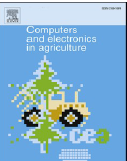 Computers and Electronics in Agriculture 222 (2024) 109080; https://doi.org/10.1016/j.compag.2024.109080
Computers and Electronics in Agriculture 222 (2024) 109080; https://doi.org/10.1016/j.compag.2024.109080
Bao Huy, Nguyen Quy Truong, Krishna P. Poudel, Hailemariam Temesgen, Nguyen Quy Khiem.
Abstract: The development and evaluation of new methods for the measurement, monitoring, and assessment of forest carbon biomass is necessary to quantify the ecosystem services provided by forests. To that end, multi-output deep learning (MODL) models were developed, cross-validated as alternative to the conventional weighted nonlinear seemingly unrelated regression (WNSUR) method for simultaneous prediction of tree aboveground biomass (AGB), tree belowground biomass (BGB), and total tree biomass (TB = AGB + BGB), while ensuring additivity, in two main tropical forest types – Dipterocarp Forest (DF) and Evergreen Broadleaf Forest (EBLF).  A destructive sample of 175 trees was collected from 27 purposively selected plots in the Central Highlands ecoregion of Vietnam. The potential predictors of AGB, BGB and TB included four tree-level variables (diameter at breast height, DBH; tree height, H; wood density, WD; and crown area, CA), three stand-level variables (Forest type; basal area, BA; and stand density, N), and five environmental variables (mean annual rainfall, P; mean annual temperature, T; Soil type; Altitude; and Slope). The model utilizing DBH, CA, H, WD, BA, Altitude, P, and Forest type as predictors performed the best among the MODL models developed in this study. Compared to WNSUR models that used the same set of predictors and the dataset from the same forest types of DF or EBLF, the MODL models reduced the mean absolute percent error of tree AGB, BGB, and TB by up to 24.7 %, 96.5 %, and 9.4 %, respectively. The results suggest that the MODL algorithm can be applied on a diverse spatial scale, covering gradients of forest stand characteristics, climate conditions, soil properties, and topography, as it can incorporate complex numerical and categorical variables into the models without requiring a priori functions.
A destructive sample of 175 trees was collected from 27 purposively selected plots in the Central Highlands ecoregion of Vietnam. The potential predictors of AGB, BGB and TB included four tree-level variables (diameter at breast height, DBH; tree height, H; wood density, WD; and crown area, CA), three stand-level variables (Forest type; basal area, BA; and stand density, N), and five environmental variables (mean annual rainfall, P; mean annual temperature, T; Soil type; Altitude; and Slope). The model utilizing DBH, CA, H, WD, BA, Altitude, P, and Forest type as predictors performed the best among the MODL models developed in this study. Compared to WNSUR models that used the same set of predictors and the dataset from the same forest types of DF or EBLF, the MODL models reduced the mean absolute percent error of tree AGB, BGB, and TB by up to 24.7 %, 96.5 %, and 9.4 %, respectively. The results suggest that the MODL algorithm can be applied on a diverse spatial scale, covering gradients of forest stand characteristics, climate conditions, soil properties, and topography, as it can incorporate complex numerical and categorical variables into the models without requiring a priori functions.
Download the article
DOI: https://doi.org/10.1016/j.compag.2024.109080
Additive modeling systems to simultaneously predict aboveground biomass and carbon for Litsea glutinosa of agroforestry model in tropical highlands.
Forest Systems, 32(1), e006. https://doi.org/10.5424/fs/2023321-19780
Bao Huy, Nguyen Quy Truong, Nguyen Quy Khiem, Krishna P. Poudel, and Hailemariam Temesgen
Photo: Agroforestry model: Litsea glutinosa and cassava in the Central Highlands of Vietnam.
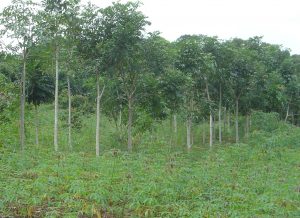 Abstract:
Abstract:
Aim of study: To develop and cross-validate simultaneous modeling systems for estimating components and total tree aboveground biomass and carbon of Litsea glutinosa in an agroforestry model with cassava.
Area of study: In the Central Highlands of Vietnam, the agroforestry model widely planted on fallow land of ethnic minorities is a mixture of 65% L. glutinosa in combination with 35% cassava (Manihot esculenta).
Material and methods: Twenty-two 300-m2 circular sample plots were located, representing the range of tree age, plantation density, . In each sample plot, one selected tree with a diameter at breast height equal to the plot quadratic mean diameter was destructively sampled. The relationships among tree aboveground biomass and carbon (AGB/AGC) and their components with dendrometric variables diameter, height, age, and crown area were examined using factor analysis. To fit systems of equations for AGB/AGC and their components, we compared two methods: weighted nonlinear least-squares (WNLS) and weighted nonlinear seemingly unrelated regression (WNSUR).
Main results: The results of the leave-one-out cross-validation showed that the simultaneous WNSUR approach to modeling systems of four tree components, total biomass, and carbon provided better results than independent WNLS models.
Research highlights: The simultaneous WNSUR modeling system provided improved and reliable estimates of tree components, total biomass, and carbon for L. glutinosa in an agroforestry model with cassava compared to independently fitted WNLS models.
Additional keywords: simultaneous modeling system; tree biomass-carbon; weighted non-linear-SUR.
Download the article.
Download supplementary Tables S1 & S2
Stand growth modeling system for planted teak (Tectona grandis L.f.) in tropical highlands
Trees, Forests and People 9 (2022) 100308. https://doi.org/10.1016/j.tfp.2022.100308
Bao Huy, Nguyen Quy Truong, Nguyen Quy Khiem, Krishna P. Poudel, and Hailemariam Temesgen
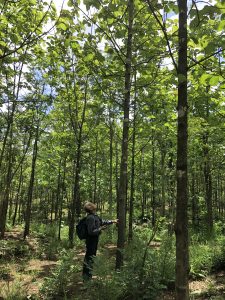 Abstract: We developed a system for modeling the growth and yield of planted teak (Tectona grandis L.f.) for small diameter products under varying management regimes in the tropical Central Highlands of Viet Nam. We compared an independent and simultaneous system of models to predict dominant height (Ho), quadratic mean diameter (Dg), averaged tree height (Hg) with Dg, and mean tree volume (V) versus stand age (A). In addition, the model system performance with and without site index (SI) and stand density (N) as covariates were compared using K-fold cross-validation. The best modeling system was obtained with the simultaneously fit models that included SI and N and were in the form of: Dg=Dm/(1+a× exp(-b×A))× exp[e1×(SI– 15) + e2/1000×(N – 722)]; Hg=Hm×exp(-a×exp(-b×A)) × exp[e1×(SI– 15) + e2/1000×(N – 722)]; and; where Dm, Hm, a, b, e1 and e2 are parameters to be estimated. These models will help predict the growth and yield of teak planted for different planting schemes, including monoculture, agroforestry, and forest enrichment planting in this region.
Abstract: We developed a system for modeling the growth and yield of planted teak (Tectona grandis L.f.) for small diameter products under varying management regimes in the tropical Central Highlands of Viet Nam. We compared an independent and simultaneous system of models to predict dominant height (Ho), quadratic mean diameter (Dg), averaged tree height (Hg) with Dg, and mean tree volume (V) versus stand age (A). In addition, the model system performance with and without site index (SI) and stand density (N) as covariates were compared using K-fold cross-validation. The best modeling system was obtained with the simultaneously fit models that included SI and N and were in the form of: Dg=Dm/(1+a× exp(-b×A))× exp[e1×(SI– 15) + e2/1000×(N – 722)]; Hg=Hm×exp(-a×exp(-b×A)) × exp[e1×(SI– 15) + e2/1000×(N – 722)]; and; where Dm, Hm, a, b, e1 and e2 are parameters to be estimated. These models will help predict the growth and yield of teak planted for different planting schemes, including monoculture, agroforestry, and forest enrichment planting in this region.
Photo: Ten-year-old teak trees planted to enrich degraded dipterocarp forest in Dak Lak province, Viet Nam
Keywords: Growth model, site index, teak in agroforestry, teak in dipterocarp forest, teak plantation, WNSUR.
Download the article: https://doi.org/10.1016/j.tfp.2022.100308
Deep learning models for improved reliability of tree aboveground biomass prediction in the tropical evergreen broadleaf forests
Forest Ecology and Management, 508 (2022) 120031: 1-13.
Bao Huy, Nguyen Quy Truong, Nguyen Quy Khiem, Krishna P. Poudel, Hailemariam Temesgen
Abstract: Aboveground biomass (AGB) and carbon uptake of a forest are key ecological indicators for various technical and scientific applications and sustainable forest management. Deep Learning (DL) methods have been considered as alternative to regression techniques to increase the reliability of tree AGB prediction. The objectives were to develop DL models to predict AGB in the tropical evergreen broadleaf forests and compare DL models with traditional regression equations for their reliability in AGB prediction. A total of 968 individual trees were destructively sampled from fourteen 1-ha and twenty-six 0.2-ha plots distributed across five ecoregions of Viet Nam to get a dataset of tree predictors of diameter at breast height (DBH), tree height (H), wood density (WD) and the response variable of AGB along with forest stand factors of basal area (BA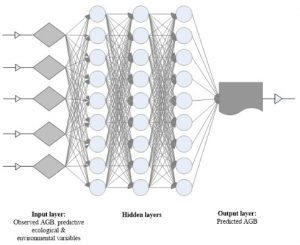 ) and density (N); ecological and environmental variables such as ecoregion, slope, altitude, soil type, averaged annual temperature (T), averaged annual rainfall (P) and averaged dry season length. The DL models were developed using different combinations of variables selected by factor analysis for mixed data and compared with traditional regression equations by using cross-validation. Trees AGB in tropical rainforest predicted by DL models had significantly higher reliability than the conventional regression equations when both had the same input variables. Of the 16 developed DL models with 1 to 9 predictors, the model with 9 predictors (DBH, H, Ecoregion, Altitude, P, T, Soil type, N and WD) was the best DL model which reduced root mean squ
) and density (N); ecological and environmental variables such as ecoregion, slope, altitude, soil type, averaged annual temperature (T), averaged annual rainfall (P) and averaged dry season length. The DL models were developed using different combinations of variables selected by factor analysis for mixed data and compared with traditional regression equations by using cross-validation. Trees AGB in tropical rainforest predicted by DL models had significantly higher reliability than the conventional regression equations when both had the same input variables. Of the 16 developed DL models with 1 to 9 predictors, the model with 9 predictors (DBH, H, Ecoregion, Altitude, P, T, Soil type, N and WD) was the best DL model which reduced root mean squ are percent error (RMSPE) and mean absolute percent error (MAPE) by up to 7.7% and 6.1%, respectively, compared to traditional allometric equations. The DL models created in this study should be applied for measured tree data following factors of the forest stand, ecology, and environment in sampled plots to predict the tree AGB and total AGB, carbon on a large scale with variation in the value of these factors. Thus, we recommend that the DL models apply for the Measurement, Reporting, and Verification (MRV) system of the Reducing Emissions from Deforestation and forest Degradation (REDD+) program at a large regional level, national or territorial level scale.
are percent error (RMSPE) and mean absolute percent error (MAPE) by up to 7.7% and 6.1%, respectively, compared to traditional allometric equations. The DL models created in this study should be applied for measured tree data following factors of the forest stand, ecology, and environment in sampled plots to predict the tree AGB and total AGB, carbon on a large scale with variation in the value of these factors. Thus, we recommend that the DL models apply for the Measurement, Reporting, and Verification (MRV) system of the Reducing Emissions from Deforestation and forest Degradation (REDD+) program at a large regional level, national or territorial level scale.
Full article
Allometric equation for estimating tree above ground biomass modified by ecological environmental factors in tropical dipterocarp forests.
XV World Forestry Congress, 2–6 May 2022, Coex, Seoul, Republic of Korea.
Bao Huy, Nguyen Thi Tinh
Abstract: Tropical Dipterocarp Forest (DF) plays an important role in mitigating climate change thanks to its carbon sequestration capacity. In order to estimate CO2 absorption capacity of DF as a basis for development of forest ecological services, a system of biomass equations is needed; while very few models for estimating biomass in DF have been published and have not yet reflected the impact of ecological environmental factors. The purpose of the study was to validate and select the best model for estimating tree above ground biomass (AGB, kg) in DF under the influence of ecological environmental factors to improve the reliability. Twenty-eight 0.25 ha plots in the Central Highlands and one 1 ha plot in the Southeast ecoregion in Viet Nam were measured. A total of 329 trees were destructively sampled to obtain a dataset of the dry biomass of AGB; Methods for developing equations were weighted nonlinear fixed/ mixed models with/without random effects fit by Maximum Likelihood; Using K-fold cross validation with K = 10, we compared and selected the best model with and without ecological environmental factors. As a result, separate ecological environmental factor did not affect AGB, while the combination of the factors influences to AGB model through the form: AGB = AVERAGE × MODIFIER, AGB = a × Db × WDd × exp (e2 × (P – 1502) + e3 × (BA – 12.62)) that was significantly more reliable than model without these factors involved; where D (cm), WD (g / cm3), P (mm year-1) and BA (m2 ha-1) are diameter at breast height, wood density, averaged annual rainfall and total basal area of forest stand respectively.
Available at: https://programme.wfc2021korea.org/en/session/21862f80-a9c1-ec11-997e-a04a5e7cf9dc
Individual tree diameter growth modeling system for Dalat pine (Pinus dalatensis Ferré) of the upland mixed tropical forests
Forest Ecology and Management, 480 (2021) 118612: 1-15.
Bao Huy, Le Canh Nam, Krishna P. Poudel, Hailemariam Temesgen.
Abstract: Pinus dalatensis Ferré (Dalat pine, or five-needle pine, locally) is an endemic large tree species of Vietnam that has both high timber and non-timber values. It is also a rare tree species listed in the Red List of the International
Union for Conservation of Nature (IUCN). The objective of this study was to develop an individual tree diameter
growth modeling syste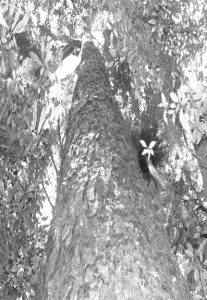 m to facilitate the sustainable management and conservation of this species. We used Haglöf Sweden ® increment borers to collect tree ring samples from a total of 56 trees resulting in a dataset of 4566 diameter at breast height (dbh, cm) measurements at age (t, year) and obtained the associated ecological environmental factors in three different sites in the Central Highlands, Vietnam. A subset of this dataset (n = 1264) also had the climate data collected over the period of past 32–38 years (from 1980 to 2011 and from 1979 to 2016). Weighted mixed-effects models were used to model Dalat pine trees growth and account for autocorrelation and heteroscedasticity of the dbh measurements. Cross validation over 200 realizations were used to select the best equation form of dbh growth and incorporate the environmental effects and climatic factors that help improve reliability of the models. Under the mixed-effects modeling paradigm, the Mitscherlich equation fitted with random effects of ecological environmental factors (eco-subregions and altitude) and climatic factors (temperature, humidity, and temperature in dry and in rainy seasons) produced the best results. Whereas, under the fixed-effect modeling paradigm, the models that used the exponential function of environmental or climatic factors as the modifiers of an average diameter growth performed the best (Bias = −5.9% and RMSE = 10.0 cm). The models developed in this study will be useful for forecasting growth and for silvicultural planning under shifting environment and climate and are expected to contribute to the sustainable management of this endemic species.
m to facilitate the sustainable management and conservation of this species. We used Haglöf Sweden ® increment borers to collect tree ring samples from a total of 56 trees resulting in a dataset of 4566 diameter at breast height (dbh, cm) measurements at age (t, year) and obtained the associated ecological environmental factors in three different sites in the Central Highlands, Vietnam. A subset of this dataset (n = 1264) also had the climate data collected over the period of past 32–38 years (from 1980 to 2011 and from 1979 to 2016). Weighted mixed-effects models were used to model Dalat pine trees growth and account for autocorrelation and heteroscedasticity of the dbh measurements. Cross validation over 200 realizations were used to select the best equation form of dbh growth and incorporate the environmental effects and climatic factors that help improve reliability of the models. Under the mixed-effects modeling paradigm, the Mitscherlich equation fitted with random effects of ecological environmental factors (eco-subregions and altitude) and climatic factors (temperature, humidity, and temperature in dry and in rainy seasons) produced the best results. Whereas, under the fixed-effect modeling paradigm, the models that used the exponential function of environmental or climatic factors as the modifiers of an average diameter growth performed the best (Bias = −5.9% and RMSE = 10.0 cm). The models developed in this study will be useful for forecasting growth and for silvicultural planning under shifting environment and climate and are expected to contribute to the sustainable management of this endemic species.
Keywords: Climatic factors, Dalat pine, Diameter growth, Environment factors, Mixed effects, Pinus dalatensis, Tree rings
Full Article
Current situation and solutions for community forest management in the Central
Highlands of Viet Nam
XV World Forestry Congress, 2–6 May 2022, Coex, Seoul, Republic of Korea.
Bao Huy, Ho Dinh Bao, Dam Viet Bac
Abstract: Community forest management has been officially recognized more clearly in Viet Nam’s new Forest
Law of 2017, so to promote community forest management, it is necessary to assess the past process and put it into new context to provide appropriate technical and policy recommendations. The fields of community forest management assessment were in Tul and Hang Nam villages, where M’Nong indigenous ethnic minorities live, in the Central Highlands, Viet Nam. Natural forests were allocated to these communities since 2002. Accordingly, Tul community had the support of a rural development project in the period of 2005-2009 to improve its capacity for management of
community forests, while the Hang Nam community did not have any significant support from outside. Participatory research methods were applied to evaluate the results and effectiveness of community forest management. The results showed that: 1) The community forest model that was granted forest use rights without any support and advice to implement community forest management (In the case of Hang Nam community), achieved the rates according to the following: organizing 13%, technical 23%, economic 33%, social: 34% and environmental: 71% and on average
35% of all objectives were met; 2) The community forest model that was granted the forest use rights and received the supports for capacity building through a 4-year project (In the case of Tul community), achieved the rates according to the following: organizing 33%; technical 36%, economic 20%, social: 77% and environmental: 77% and on average 50% of all objectives were met. In order to consolidate and develop community forest management, it is necessary to synchronously implement the following solutions: 1) Strengthen the organization and management capacity for the
communities; 2) Improve community livelihoods from forest management; 3) There is a need of more appropriate policies for community forest management; 4) Apply measures to rehabilitate degraded forests.
Available at: https://programme.wfc2021korea.org/en/session/cb8bd6d3-84c0-ec11-997e-a04a5e7cf9dc
Individual Plant Allometric Equations for Estimating Aboveground Biomass and Its Components for a Common Bamboo Species (Bambusa procera A. Chev. and A. Camus) in Tropical Forests.
Forests 2019, 10(316): 1-17
Authors: Bao Huy, Giang Thi Thanh, Krishna P. Poudel and Hailemariam Temesgen
Abstract: Bamboo forests play an important role in achieving the objectives of the United Nations program on Reducing Emission from 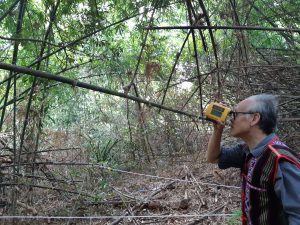 Deforestation and Forest Degradation. We developed and validated a modeling system that simultaneously estimate aboveground biomass and its components for a common bamboo species (Bambusa procera A. Chev. and A. Camus) in tropical forests. Eighty-three bamboo culms were destructively sampled from seventeen 100 m2 sample plots located in different parts of the Central Highlands in Viet Nam to obtain total plant aboveground biomass (AGB) and its components. We examined the performance of weighted nonlinear models fit by maximum likelihood and weighted nonlinear seemingly unrelated regression fit by generalized least squares for predicting bamboo biomass. The simultaneous estimation of AGB and its components produced higher reliability than the models of components and total developed separately. With a large number of bamboo species, it may not be feasible to develop species- specific biomass models, hence genus-specific allometric models may be considered.
Deforestation and Forest Degradation. We developed and validated a modeling system that simultaneously estimate aboveground biomass and its components for a common bamboo species (Bambusa procera A. Chev. and A. Camus) in tropical forests. Eighty-three bamboo culms were destructively sampled from seventeen 100 m2 sample plots located in different parts of the Central Highlands in Viet Nam to obtain total plant aboveground biomass (AGB) and its components. We examined the performance of weighted nonlinear models fit by maximum likelihood and weighted nonlinear seemingly unrelated regression fit by generalized least squares for predicting bamboo biomass. The simultaneous estimation of AGB and its components produced higher reliability than the models of components and total developed separately. With a large number of bamboo species, it may not be feasible to develop species- specific biomass models, hence genus-specific allometric models may be considered.
Keywords: bamboo biomass; genus-specific model; seemingly unrelated regression; simultaneous biomass estimation
It is available online: PDF Version: https://www.mdpi.com/1999-4907/10/4/316/pdf
Enhancing Local Adaptive Capacities of Selected Upland Farming Communities in Southeast Asia: Lessons and Experiences
Asian Journal of Agriculture and Development (AJAD), June 2019, Vol. 16 No. 1: pp. 117-131
Authors: L.D. Landicho, C. Wulandari, B. Huy, R.G. Visco, W.M. Carandang, and R.E.D. Cabahug
Abstract: This article highlights the experiences and lessons generated by the project collaborators in enhancing the adaptive capacities of selected upland farming communities in Southeast Asia. The project collaborators employed capability building programs, such as farmers’ and technicians’ training,
local climate change awareness programs, cross-farm visits, demonstration plots showcasing agroforestry technologies as climate change adaptation (CCA) strategies, and linking science with policies. The outcomes of the project indicate that this program was able to enhance the local adaptive capacities of the upland farming communities by building their key community assets, creating knowledge and information, initiating innovations, strengthening institutions, and initiating forward-looking decision making and governance. The lessons and experiences generated from these initiatives could serve as important reference for scaling up the project. The outputs and outcomes of the capacity development initiatives have generated lessons that could contribute to the body of knowledge in CCA, particularly on enhancing the adaptive capacities for CCA.
Keywords: agroforestry, policymaking processes, communicators, upland farming communities, scaling up
Download Full Article
Link to website of the AJAD and the article: http://ajad.searca.org/read-articles/13-view-article?aid=776
Taxon- specific modeling systems for improving reliability of tree aboveground biomass and its components estimates in tropical dry dipterocarp forests 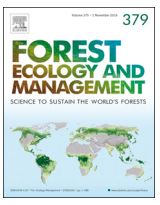
Forest Ecology and Management 437(2019): 156-174
Authors: Bao Huy, Nguyen Thi Tinh, Krishna P. Poudel, Bryce Michael Frank, Hailemariam Temesgen
Abstract: The dry dipterocarp forest (DDF) is a major and unique forest type in Asia providing both protection and production functions. DDF’s role as a carbon sink is important in Asia, but there is a deficiency in existing biomass models for these forests. This study aimed to develop simultaneous modeling systems to estimate tree above-ground biomass (AGB) and its components for mixed species, dominant family, genera, and species. Twenty-eight 0.25 ha plots in the Central highlands and one 1 ha plot in the Southeast ecoregion in Viet Nam were measured. A total of 329 trees were destructively sampled to obtain a dataset of the dry biomass of the stem (Bst), branches (Bbr), leaves (Ble), bark (Bba), and AGB. Using K-fold cross validation, we compared AGB predictions from independently developed AGB equation and from a system of biomass equations that estimated component biomass and AGB simultaneously. The estimation methods for independent equation was weighted nonlinear regression fit by maximum likelihood and for simultaneous system it was weighted nonlinear seemingly unrelated regression (SUR) fit by generalized least squares. We also examined different modeling systems for different plant classification at taxonomic levels. The selected form of taxon-specific modeling systems were AGB = a1×Db11×Hb12×WDb13 + a2×Db21 + a3×Db31 + a4×Db41 for mixed species and dominant Dipterocarpaceae family and AGB = a1×Db11 + a2×Db21 + a3×Db31 + a4×Db41 for dominant genera of Dipterocarpus and Shorea. The predictors of D, H, and WD are diameter at breast height, tree height and wood density, respectively. Compared to the mixed species modeling system, genus-specific modeling systems improved the reliability of AGB estimation substantially and will reduce the cost of application because the only predictor required for measurement is D. The pantropical genus-specific modeling systems are more reliable than pantropical mixed species models.
Key words: Biomass, Carbon, Dipterocarpus genus, Genus-specific model, Seemingly unrelated regression (SUR), Shorea genus
The impact of forestry policies on ethnic minorities in the Central Highlands of Viet Nam.
Journal of the International Academy for Case Studies, 2(26): 1-14.
Tran Quoc Hung, Dang Kim Vui, Do Hoang Chung, Bao Huy
Case description: In order to assess the impacts of forestry policies on ethnic minorities in the Central Highlands of Vietnam in the protection and development of forest resources from the renovation stage to the present (the year 1986 up to now), the research topic has been studied from reports and applied forestry policy documents as well as analysis scientific articles. The research also carried out surveys in 2 provinces of Gia Lai and Dak Lak with representative’s households.
The research results have showed that the government’s forest protection and development policies have impacted on the lives of ethnic minority communities in the Central Highlands of Vietnam in both positive and negative aspects. So far, the status of forests allocated to ethnic minority households and communities in the Central Highlands has been affected to varying degrees. The forest management of households and communities faces many challenges; Benefit from the forest protection and management has not yet contributed to household livelihood income, so it has not attracted people interested in forestry and forest management and protection. The rate of forest allocation to households and communities in the Central Highlands region of Vietnam is generally very low, only about 3.9% of the forest area and forestry land. Therefore, it is necessary to have specific solutions and policies to develop livelihoods for ethnic minorities in the Central Highlands in association with sustainable forest management.
Key words: Forestry Policy, Livelihood, Ethnic Minority, Central Highlands
Download the article: http://baohuy-frem.org/wp-content/uploads/2020/09/74.-The-impact-of-forestry-policies.pdf
Analysis, evaluation and ways for rational land management of north Vietnam (Suoi sap catchment basin).
Ecosystems: Ecology and Dynamics, 3(3): 116 – 124. ISSN: 2542-2006
Demidov, V.V., Shchegolkova, N.M., Hai, V.D., Khoa, P.V., Huy, B.
Abstract: In this article we present the analysis of practical and economical use of the territory of Suoi Sap catchment basin, Son-La province, Vietnam. We used the data of a route survey, performed by the Vietnam National Forestry University, for the assessment. We analyzed the climatic conditions, soil and vegetation resources, and economical use of the territory. The research territory is located in the Northern, mountainous part of Vietnam. It was determined that the slopes of the length from 500 to 2000 m (87%) with steepness from 10 to 40 (90%) prevail in the catchment area. The amount of precipitation (rain) is more than 1750 mm, with most of them falling in summer-autumn (May- September). This leads to the spread of erosion processes, an increase of polluted and degraded lands. In this regard, the organization of rational and efficient use of land should include the creation of optimal conditions for the reproduction and protection of soil fertility, increasing its role in agricultural production. The scientifically based analysis of the impact of natural and other factors on the state of land resources of the catchment area allows us to recommend the use of the most rational and correct criteria and methods of land use in the area. In general, the solution of this problem for similar territories of Vietnam requires the definition of criteria for the ecological and economic efficiency of land use, the analysis of land use, the development of a scientific and methodological approach to the qualitative assessment of land use control in the context of the development of an agrarian economy. WOCAT system has been used in the development of effective watershed land-use technologies.
Keywords: Vietnam, rational lands management, catchment basin, WOCAT.
Download Article
Assessment of Enrichment Planting of Teak (Tectona grandis) in the Degraded Dry Deciduous Dipterocarp Forest in the Central Highlands, Viet Nam
Southern Forests: A Journal of Forest Science, 80(1):75-84
Bao Huya, *, Pham Cong Trib, Tran Trietc,d
a, * Corresponding author, Department of Forest Resources and Environment Management, Tay Nguyen University, 567 Le Duan, Buon Ma Thuot, Dak Lak, Viet Nam, email: baohuy.frem@gmail.com, tel:+84983084145, fax: +845003825553.
b W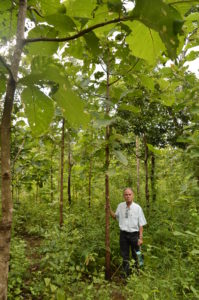 estern Highlands Agriculture and Forestry Science Institute (WASI), 53 Nguyen Luong Bang, Buon Ma Thuot, Dak Lak, Viet Nam, email: pcotri@gmail.com, tel:+84905361262.
estern Highlands Agriculture and Forestry Science Institute (WASI), 53 Nguyen Luong Bang, Buon Ma Thuot, Dak Lak, Viet Nam, email: pcotri@gmail.com, tel:+84905361262.
c University of Science, Vietnam National University Ho Chi Minh City, 227 Nguyen Van Cu, District 5, Ho Chi Minh City, Vietnam, email: ttriet@gmail.com, Tel: +84838307077.
d International Crane Foundation, E-11376 Shady Lane Road, Baraboo, Wisconsin, USA 53913, email: triet@savingcranes.org, Tel: +16083569462 ext. 152.
Abstract: After years of unsustainable logging, the Dry Deciduous Dipterocarp Forest (DDDF) has become poor in timber stocks and it has been converted to industrial crops such as rubber (Hevea brasiliensis). The objectives of this study were to assess teak (Tectona grandis L.f.) tree establishment under degraded DDDF conditions and to determine factors that influence the suitability of teak as a forest enrichment tree species. A set of 64 experimental plots of 4,900 m2 each was set up and observed for 4 – 5 years for testing enrichment planting with teak under various combinations of two groups of factors: ecological conditions and forest status. Weighted, nonlinear, multivariate regression models were used to detect key factors that influenced the suitability of teak. The results showed that at the age of 4 years the average dominant tree height (defined as 20% of the tallest trees in the experimental plot) reached 11.2, 7.8, 5.3, and 3.8 m for very good, good, average, and poor suitability levels, respectively. Survival rates of planted teak from average to very good suitability levels were over 90%. Six key factors that affected the suitability of teak were waterlogging during the rainy season, altitude, stand volume of the degraded DDDF, soil type, percentage of sand, and concentration of P2O5 in the soil. Under extreme ecological and environmental conditions of the DDDF, enrichment planting with teak gave promising results.
Keywords: degraded dipterocarp status, dipterocarp enrichment, teak suitability assessment.
Citation: Bao Huy, Pham Cong Tri & Tran Triet (2018): Assessment of enrichment planting of teak (Tectona grandis) in degraded dry deciduous dipterocarp forest in the Central Highlands, Vietnam, Southern Forests: a Journal of Forest Science, 80(1): 75-84, DOI: 10.2989/20702620.2017.1286560
Click on the link to take full article: http://www.tandfonline.com/eprint/HDmu9hZD6xWNIXcuz2GK/full or download the article here
Simultaneous estimation of above- and below-ground biomass in tropical forests of Viet Nam
Forest Ecology and Management 390 (2017) 147–156
Karin Kraliceka, Bao Huya,b, Krishna P. Poudela, Hailemariam Temesgena, Christian Salasc
a Department of Forest Engineering, Resources, and Management, Oregon State University, Corvallis, OR 97333, USA
b Department of Forest Resources and Environment Management, Tay Nguyen University, 567 Le Duan, Buon Ma Thuot, Dak Lak 630000, Viet Nam.
c Laboratorio de Biometria, Departamento de Ciencias Forestales, Universidad de La Frontera, Temuco, Chile
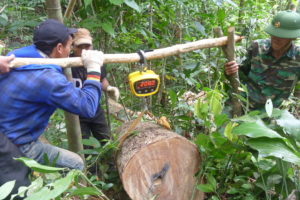 Abstract: For carbon accounting or for developing REDD+ (Reducing Emissions from Deforestation and forest Degradation) programs, allometric equations for estimating both above-ground biomass (AGB) and below-ground biomass (BGB) are useful. We developed systems of weighted nonlinear allometric equations to estimate total, above- and below-ground biomass for Dipterocarp forests (DF) and Evergreen broadleaf forests (EBLF) in the Central Highlands of Viet Nam, as well as for a dominant plant family (Dipterocarpaceae; Dip) in the DF. A total of 175 trees were destructively sampled for both AGB and BGB, with whole root extraction as the method of BGB sampling. Different equation forms for AGB and BGB incorporating diameter at breast height (D), tree height (H), wood density (WD) and crown area (CA) were evaluated. The best system of equations for the DF, Dipterocarpaceae in the DF, and EBLF was selected based on validation statistics of percent bias (PBias), mean absolute percentage error (MAPE), and root mean squared percent error (RMSPE). All three systems of equations developed in this study used D2×H×WD as a predictor for AGB and a simpler BGB equation form with either D2×H or D as the sole predictor variable. The addition of WD or CA to BGB equation forms did not substantially improve validation statistics over simpler forms. These allometric equations should contribute to advancing our understanding of carbon distribution of trees in these tropical ecosystems.
Abstract: For carbon accounting or for developing REDD+ (Reducing Emissions from Deforestation and forest Degradation) programs, allometric equations for estimating both above-ground biomass (AGB) and below-ground biomass (BGB) are useful. We developed systems of weighted nonlinear allometric equations to estimate total, above- and below-ground biomass for Dipterocarp forests (DF) and Evergreen broadleaf forests (EBLF) in the Central Highlands of Viet Nam, as well as for a dominant plant family (Dipterocarpaceae; Dip) in the DF. A total of 175 trees were destructively sampled for both AGB and BGB, with whole root extraction as the method of BGB sampling. Different equation forms for AGB and BGB incorporating diameter at breast height (D), tree height (H), wood density (WD) and crown area (CA) were evaluated. The best system of equations for the DF, Dipterocarpaceae in the DF, and EBLF was selected based on validation statistics of percent bias (PBias), mean absolute percentage error (MAPE), and root mean squared percent error (RMSPE). All three systems of equations developed in this study used D2×H×WD as a predictor for AGB and a simpler BGB equation form with either D2×H or D as the sole predictor variable. The addition of WD or CA to BGB equation forms did not substantially improve validation statistics over simpler forms. These allometric equations should contribute to advancing our understanding of carbon distribution of trees in these tropical ecosystems.
Keywords: Additivity principle, Dipterocarp forest, Evergreen broadleaf forest, System of equations,Tropical forest
Citation: Kralicek, K., Huy, B., Poudel, K.P., Temesgen, H., Salas, C. 2017. Simultaneous estimation of above- and below-ground biomass in tropical forests of Viet Nam. Forest Ecology and Management 390 (2017) 147–156.
Download: Article – Total biomass equations in tropical forests
Allometric Equations for Estimating Tree Aboveground Biomass in Evergreen Broadleaf Forests of Viet Nam
Forest Ecology and Management 382(2016): 193-205
Bao Huya, b, Karin Kralicekb, Krishna P. Poudelb, Vu Tan Phươngc, Phung Van Khoad, Nguyen Dinh Hunge, Hailemariam Temesgenb, *
a Department of Forest Resources and Environment Management, Tay Nguyen University, 567 Le Duan, Buon Ma Thuot, Dak Lak, Viet Nam; Email: baohuy.frem@gmail.com, bao.huy@oregonstate.edu.
b Department of Forest Engineering, Resources, and Management, Oregon State University, Corvallis, OR 97333, USA.
c Vietnamese Academy of Forest Sciences, Đuc Thang, Bac Tu Liem, Ha Noi, Viet Nam.
d Viet Nam National University of Forestry, Xuan Mai, Chuong My, Ha Noi, Viet Nam.
e Forest Inventory and Planning Institute, Vinh Quynh, Thanh Tri, Ha Noi, Viet Nam.
* Corresponding author. Tel: +1 5417378549; Fax: +1 5417379126; E-mail: hailemariam.temesgen@oregonstate.edu 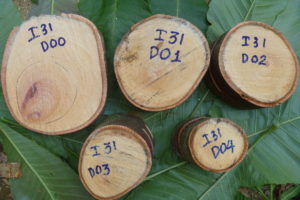
ABSTRACT For mitigating climate change through carbon sequestration and for reporting, Viet Nam needs to develop biomass equations at a national scale. These equations need to be accurate and provide quantifiable uncertainty. Using data from 968 trees across five ecoregions of Viet Nam, we developed a set of models to estimate tree aboveground biomass (AGB) in evergreen broadleaf forests (EBLF) at the national level. Diameter at breast height (DBH), tree height (H), wood density (WD), and combination of these three tree characteristics were used as covariates of the biomass models. Effect of ecoregion, wood density, plant family on AGB were examined. Best models were selected based on AIC, Adjusted R2, and visual interpretation of model diagnostics. Cross-validation statistics of percent bias, root mean square percentage error (RMSPE), and mean absolute percent error (MAPE) were computed by randomly splitting data 200 times into model development (80%) and validation (20%) datasets and averaging over the 200 realizations. Effects models were used, the best results were obtained by using a combined variable (DBH2HWD (kg) = (DBH (cm)/100)2×H (m)×WD (g/cm3)×1000) model AGB = a×(DBH2HWD)b. Including a categorical WD variable as a random effect reduced AIC, percent bias, RMSPE, MAPE of models AGB = a×DBHb and AGB = a×(DBH2H)b; ecoregion as a random effect reduced the AIC of models AGB = DBHb×WD, AGB = a×(DBH2H)b, and AGB = a×(DBH2HWD)b. For models that did not include WD variable, including plant family as a random effect reduced AIC, RMSE, and MAPE; recommendations are provided for models with specific parameters for main families and without WD if this variable is not available. The overall best model for estimating AGB was the equation form AGB = a×(DBH2HWD)b with ecoregion as a random effect.
Keywords: Aboveground biomass, allometric equation, climate change, evergreen broadleaf forest, ecoregions of Viet Nam, plant family
Citation: Huy, B., Kralicek, K., Poudel, K.P., Phương, V.T., Khoa, P.V., Hung, N.D., Temesgen, H. 2016. Allometric Equations for Estimating Tree Aboveground Biomass in Evergreen Broadleaf Forests of Viet Nam. Forest Ecology and Management 382(2016): 193-205. The link to access the article: http://authors.elsevier.com/a/1Tu5O1L~Gw8-qj http://dx.doi.org/10.1016/j.foreco.2016.10.021
Download: Article – Biomass Equations in evergreen forests Final
Allometric Equations for Estimating Tree Aboveground Biomass in Tropical Dipterocarp Forests of Viet Nam
Forests, 2016, 7, 180:1-19; doi: 10.3390/f7080180
Bao Huy, Krishna P. Poudel, Karin Kralicek, Nguyen Dinh Hung, Phung Van Khoa, Vu Tan Phương and Hailemariam Temesgen.

Abstract: There are few allometric equations available for dipterocarp forests, despite the fact that this forest type covers extensive areas in tropical Southeast Asia. This study aims to develop a set of equations to estimate tree aboveground biomass (AGB) in dipterocarp forests in Viet Nam and to validate and compare their predictive performance with allometric equations used for dipterocarps in Indonesia and pantropical areas. Diameter at breast height (DBH), total tree height (H), and wood density (WD) were used as input variables of the nonlinear weighted least square models. Akaike information criterion (AIC) and residual plots were used to select the best models; while percent bias, root mean square percentage error, and mean absolute percent error were used to compare their performance to published models. For mixed-species, the best equation was . When applied to a random independent validation dataset, the predicted values from the generic equations and the dipterocarp equations in Indonesia overestimated the AGB for different sites, indicating the need for region-specific equations. At the genus level, the selected equations were and for two genera, Dipterocarpus and Shorea, respectively, in Viet Nam. Compared to the mixed-species equations, the genus-specific equations improved the accuracy of the AGB estimates. Additionally, the genus-specific equations showed no significant differences in predictive performance in different regions (e.g., Indonesia, Viet Nam) of Southeast Asia.
Keywords: aboveground biomass; allometric equation; dipterocarp forest; genus; Southeast Asia
Ciatation: Huy, B., Poudel, K.P., Kralicek, K., Hung, N.D., Khoa, P.V., Phương, V.T., and Temesgen, H. 2016. Allometric Equations for Estimating Tree Aboveground Biomass in Tropical Dipterocarp Forests of Viet Nam. Forests 2016, 7, 180:1-19; doi: 10.3390/f7080180
Aboveground Biomass Equations for Evergreen Broadleaf Forests in South Central Coastal Ecoregion of Viet Nam: Selection of Eco-regional or Pantropical Models
Forest Ecology and Management 376(2016) 276 – 283.
Bao Huya, b, Krishna P. Poudelc, Hailemariam Temesgend, *
a: Department of Forest Resources and Environment Management, Tay Nguyen University (TNU), 567 Le Duan, Buon Ma Thuot, Dak Lak, Viet Nam; Email: Baohuy.frem@gmail.com
b: Department of Forest Engineering, Resources and Management, 117 Peavy Hall, Oregon State University, Corvallis, OR 97333, USA. Email: Bao.Huy@oregonstate.edu
c: Department of Forest Engineering, Resources and Management, Oregon State University (OSU), Corvallis, OR 97333, USA. Email: Krishna.Poudel@oregonstate.edu
d: Department of Forest Engineering, Resources and Management, 233 Peavy Hall, Oregon State University (OSU), Corvallis, OR 97333, USA. Email: Temesgen.Hailemariam@oregonstate.edu.
*: Corresponding author. Email: hailemariam.temesgen@oregonstate.edu. Phone: 541-737-8549; Fax: 541-737-9126 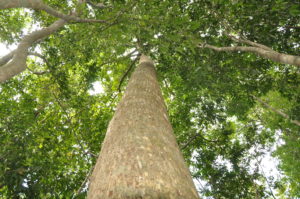
Abstract: As part of Viet Nam’s effort to participate in REDD+ (reducing emissions from deforestation and forest degradation), selected biomass equations were evaluated for their predictive abilities using data collected from destructively sampled 110 trees from 41 species of the evergreen broadleaf forests of the South Central Coastal region of Viet Nam. Different power models that used diameter at breast height (DBH), tree height (H), wood density (WD), and crown area (CA) as covariates to predict aboveground biomass (AGB) were evaluated. Best models were selected based on the coefficient of determination (R2), the Akaike information criterion (AIC), and root mean square percent error (RMSE). AGB was strongly related to four covariates – DBH, H, WD, and CA. While seldom mentioned in the existing literature, CA improved the accuracy of the AGB estimation. Accuracy of the selected models was validated using the random validation dataset and the model with four explanatory variables (AGB = a×(DBH2HWD)b×CAc) had the lowest mean absolute percent error of 16.9 percent. Using local data, a simple power model based on DBH only (AGB =a×DBHb) produced higher accuracy than the generic pantropical models that used up to three variables.
Key words: Aboveground biomass, allometric equation, eco-region, evergreen broadleaf forest, pantropic equations, South Central Coastal Region of Viet Nam.
Citation: Huy, B., Poudel, K.P., Temesgen, H. 2016. Aboveground Biomass Equations for Evergreen Broadleaf Forests in South Central Coastal Ecoregion of Viet Nam: Selection of Eco-regional or Pantropical Models. Forest Ecology and Management 376(2016) 276 – 283.
Download: Article – Biomass equations in region
Building capabilities of local climate change communicators towards climate change adaptation in the upland communities in Southeast Asia.
Article of APN Science Bulletin Issue 6 (April 2016):41-46, APN E-Lib.
Carangdang, W.M., Landicho, L.D., Visco, R.G., Huy, B., Wulandar, C., Vilayphone.
Abstract: This article highlights the experiences of the Southeast Asian Network for Agroforestry Education (SEANAFE) and its collaborators in implementing capacity devel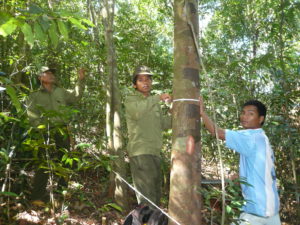 oment activities for climate change adaptation of upland comminities in the four collaborating countries, namely Indonesia, Lao, Philippines and Viet Nam. This capacity-building project focuses on the training of local climate change communicators who would serve as the local trainers and disseminaators of climate change -related to issues and development among the local community members. it also aims to continuously build awareness among the local stakeholders about climate change issues, causes, impacts and adatation strategies. Among the outputs of this project are the information materials on climate change and a policy brief would be used as an instrument in lobbying local policy makers.
oment activities for climate change adaptation of upland comminities in the four collaborating countries, namely Indonesia, Lao, Philippines and Viet Nam. This capacity-building project focuses on the training of local climate change communicators who would serve as the local trainers and disseminaators of climate change -related to issues and development among the local community members. it also aims to continuously build awareness among the local stakeholders about climate change issues, causes, impacts and adatation strategies. Among the outputs of this project are the information materials on climate change and a policy brief would be used as an instrument in lobbying local policy makers.
Key words: Local communicators, climate change, policy brief, Southeast Asia, upland communities.
Citation: Carangdang, W.M., Landicho, L.D., Visco, R.G., Huy, B., Wulandar, C., Vilayphone, A. 2016. Building capabilities of local climate change communicators towards climate change adaptation in the upland communities in Southeast Asia. APN Science Bulletin Issue 6 (April 2016):41-46, APN E-Lib, Available at: http://www.apn-gcr.org/resources/items/show/2037 accessed April 30, 2016, ISSN 2185-761X.
Full paper: APN Science Bulletin 2016
Development of participatory forest carbon monitoring in Vietnam
Paper of the XIX World Forestry Congress on 7-11 September 2015 in Durban, South Africa.
Bao Huy. 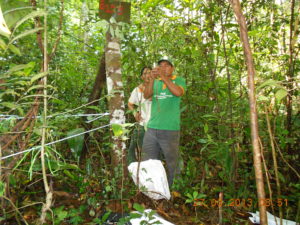
Abstract: The implementation of forestland allocation, management and protection of existing forests, and development of new forestry programmes that incentivise people based on performance such as Reducing Emissions from Deforestation and Forest Degradation (REDD+) and/or Payment for Ecosystem Services (PES) from forest resources needs a monitoring system to collect, store and analyse forest attributes in general and biomass carbon in particular based on which performance can be evaluated. The system could benefit from direct participation of households and forest owners, local government agencies. Such a participatory approach in monitoring system ensures improved forest conditions and provide greater quality and quantity of information on forests and impacts of management interventions, thereby contributing to the national forest inventory (NFI). For this reason, approach of Participatory Forest Carbon Monitoring developed (PCM) presents simple methods for measuring forest biomass carbon stocks to be applied by local technical staff and local people so that they can measure and monitor forest carbon and ensure reliable information towards claims for REDD+ benefits. Households and communities who have been assigned to or are allocated with forest for management are included as key actors in participatory carbon monitoring. The basic parameters such as tree species, diameter at breast height (DBH), height (H) are measured within sample plots determined/established by NFI. The change in forest area is also monitored as frequently as annually or periodically. The approach of the PCM that was developed and tested in the areas of UN-REDD+ Program Vietnam, involved local households, forest owners, local staffs to ensure that local stakeholders take active participation in forest management and assist in gathering or providing qualitative and quantitative information on the forests allocated to them or managed under the contract with forest owner.
Keywords: Forest carbon, local people, forest monitoring, participatory, stakeholder, Viet Nam
Citation: Bao Huy 2015. Development of participatory forest carbon monitoring in Vietnam. Paper for the XIX World Forestry Congress on 7-11 September 2015 in Durban, South Africa. Available at http://foris.fao.org/wfc2015/api/file/5528bb539e00c2f116f8e095/contents/0b0ecc8f-4385-4491-a7e0-df8e367d2eaa.pdf
Equity Case Study Brief: Establishing a Benefit Sharing Mechanism. Bu Nor B Village, Viet Nam.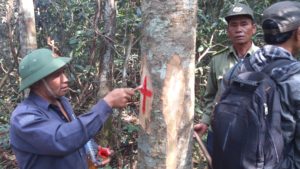
Luong Quang Hung,
RECOFTC – The Center for People and Forests.
Abstract: This is a positive equity case in community-based forest governance, focusing on providing incentives for local community in forest management via benefit sharing mechanism.
Allometric equations at national scale for estimating tree and forest biomass in Viet Nam
Paper of the XIV World Forestry Congress, Durban, South Africa, 7-11 September 2015
Bao Huy
Abstract: Natural forest types of Viet Nam thus no tools have been developed to estimate its carbon stock at national level. In the context of climate change mitigation through forestry sector and REDD+ mechanism, developing allometric equations with a dataset of tree biomass at national level could provide improved carbon stock estimates, with a known accuracy. This study developed a set of models to estimate above ground biomass (AGB) in evergreen broadleaf forests (EBLF). The dataset for EBLF included 860 trees located in five eco-regions of Viet Nam. DBH (diameter at breast height), H (tree height), WD (wood density) were used as input variables. The modelling was performed by applying non-linear mixed effect models and power models on residuals, with or without random effects of eco-regions or environment variable to models’ parameters. Indicators to select the best models were the Akaike information criterion (AIC), the sum of squared error (SSE), and R2 as well as visual interpretation of each model. An independent dataset with 1,303 trees was used for validation, with bias (percent error of total trees, S%), efficiency factor (EF) and mean absolute percent error (MAPE%) were the main indicators for validation of selected. The results indicated that random effects of eco-regions improved estimates; the best model of AGB = a*[(DBH/100)^2*H*WD]^b had the highest accuracy with a S% bias under 3%, MAPE% < 18% and EF of more than 0.95. By using the best model of this study, MAPE% was reduced significantly by 14 percent compared to models from IPCC (2003) and Brown (1997) and 10-18 percent to Chave (2005, 2014).
Keywords: Allometric equation, evergreen broadleaved forest, tree biomass, Viet Nam
Citation: Huy, B. 2015. Allometric equations at national scale for estimating tree and forest biomass in Viet Nam. Paper of the XIV World Forestry Congress, Durban, South Africa, 7-11 September 2015. Available at http://foris.fao.org/wfc2015/api/file/5523d18a3dbdfa993c7b3812/contents/771db5ca-9e2c-487c-ad7d-29fefabeedb5.pdf
Paper -Allometric equation Vietnam – Bao Huy Final
Estimating CO2 sequestration in natural broad-leaved evergreen forests in Vietnam
APANews, 32(2008): 7-10
Bao Huy, Pham Tuan Anh
Objective: The research aimed to contribute to the development and application of estimating CO2sequestration in natural forests. Results will contribute to the development of mechanisms to determine economic values of forests, and payments for environmental services.
Keywords: CO2 sequestration, Natural forest
Citation: Huy, B., Anh, P.T., 2008. Estimating CO2 sequestration in natural broad-leaved evergreen forests in Vietnam. Asia-Pacific Agroforestry Newletter, APANews, FAO, SEANAFE, 32(2008): 7-10. ISSN: 0859-9742
Full Article: APaNews 2008 CO2 Huy Anh Article
CO2 SEQUESTRATION ESTIMATION FOR THE LITSEA – CASSAVA AGROFORESTRY MODEL IN THE CENTRAL HIGHLANDS OF VIETNAM
Abstract of World Congress on Agroforestry 10-13 Feb. 2014, New Delhi, India. Tree for Life: Accelerating the Impact of Agroforestry
Bao Huy
Abstract: The Litsea – Cassava agroforestry model has been popularly practiced in the Central Highlands of Vietnam, producing a stable volume and contributing significantly to household income. This model overcomes the shortcomings of mono-cultivation of cassava on land under shifting cultivation; in addition, according to many cycles, the model helps store carbon; therefore, it is significant in reducing the greenhouse effect, which has become a global concern in recent years. In order to estimate the environment value of stored carbon of this model, the experimental method for involves: sample plot, destructive sampling, conducting chemical laboratory tests to determine the stored carbon in the components of the tree; and then using multi-variables to estimate the biomass and stored carbon in the agroforestry models. This procedure forms the basis of predicting the CO2 concentration in woody trees in the agroforestry model according to the age period, the cycle, and different combinations. The cycle of Litsea business varied over the 5-10 year period, while absorbed CO2 in the agroforestry model varied from 25 to 84 tons per hectare. Within cycle of 2 and 3 of this model, maintaining 2-3 shoots/stump of Litsea will have the greatest effect not only on productivity, but also on absorbed CO2
Key words: Agroforestry, Cassava, CO2 sequestration, Litsea glutinosa.
Citation: Huy, B., 2014. CO2 sequestration estimation for the Litsea – Cassava Agroforestry Model in the Central Highlands of Vietnam. World Congress on Agroforestry, New Delhi, India, 10-13, 2014, Compendium of Abstracts, ISBN: 978-92-9059-372-0, pp18
Compendium of Abstracts – World Congress on Agroforestry Delhi 2014, pp 18
State of Agroforestry Research and Development in Viet Nam.
APANews, 38(2011): 7-10
Bao Huy, Vo Hung
Citation: Huy, B., Hung, V. 2011. State of Agroforestry Research and Development in Viet Nam. APANews, 38(2011): 7-10
Full article: APANews State of Agroforesty
Increased income and absorbed carbon found in Litsea glutinosa – cassava agroforestry model.
APANews (Asia-Pacific Agroforestry Newsletter), FAO, SEANAFE, No. 35(2009):4-5, ISSN 0859-9742.
Bao Huy
Citation: Bao Huy (2009): Increased income and absorbed carbon found in Litsea glutinosa – cassava agroforestry model. APANews (Asia-Pacific Agroforestry Newsletter), FAO, SEANAFE, No. 35(2009):4-5, ISSN 0859-9742.
Article: Litsea income in Agroforestry
Forest Management and Benefit Sharing in Forest Land Allocation – Case study in the Central Highlands.
Proceedings of the forest land allocation forum. Ha Noi, 29 May 2008, Tropenbos International Vietnam. Thu Do Ltd. Comapany, pp 94-110
Bao Huy
Citation: Huy, B. (2008): Forest Management and Benefit Sharing in Forest Land Allocation – Case study in the Central Highlands. Proceedings of the forest land allocation forum. Ha Noi, 29 May 2008, Tropenbos International Vietnam. Thu Do Ltd. Comapany, pp 94-110
Full paper: Benefit Sharing
Community Forest Management (CFM) in Viet Nam: Sustainable Forest Management and Benefit Sharing
Paper for the Conference
Citation: Huy, B. 2007. Community Forest Management (CFM) in Vietnam: Sustainable Forest Management and Benefit Sharing. Proceedings of the International Conference on Managing Forest for Poor Reduction: Capturing Opportunities in Harvesting and Wood Processing for the benefit of the Poor, from 03 – 06 October 2006 in HCMC Vietnam, FAO, RECOFTC, SNV. ISBN 978-974-7946-97-0 Table of Contents of the Proceedings: A Cut for The Poor Conference
Full Paper: CFM paper for Conference FAO
BOOK OF ABSTRACTS. 2nd INTERNATIONAL AGROFORESTRY CONGRESS “agroforestry for sustainable and resilient farming communities”
November 28-29, 2016, Tay Nguyen University, Buon Ma Thuot City, Vietnam
 Message: Southeast Asian Network for Agroforestry Education (SEANAFE) was formed with the hope of enhancing links between and among agroforestry institutions to help advance the science and practice of agroforestry. The holding of agroforestry conferences is one of the opportunities where the member-institutions of SEANAFE, together with the other agroforestry stakeholders, exchange recent agroforestry information, establish and/or renew partnerships, and chart the directions of agroforestry at the local, regional and international levels. The 2nd International Agroforestry Congress, with the theme “Agroforestry for sustainable and resilient farming communities”, will provide a forum that highlights the role of agroforestry in climate change adaptation and enhancing sustainable land management – the two most important basic considerations in upland farming communities considering the recent and emerging concerns in climate change and food production. This event will also put emphasis on the emerging programs and policies that influence agroforestry development and promotion. SEANAFE takes pride in organizing the 2nd International Agroforestry Congress, together with the Tay Nguyen University in Vietnam as the host-institution, and the University of the Philippines Los Banos. This regional network also extends its gratitude to the different agroforestry stakeholders who will take part in this agroforestry milestone. Indeed, this Agroforestry Congress would not have been convened, had it not for your expressed interest and enthusiasm to participate in this event.
Message: Southeast Asian Network for Agroforestry Education (SEANAFE) was formed with the hope of enhancing links between and among agroforestry institutions to help advance the science and practice of agroforestry. The holding of agroforestry conferences is one of the opportunities where the member-institutions of SEANAFE, together with the other agroforestry stakeholders, exchange recent agroforestry information, establish and/or renew partnerships, and chart the directions of agroforestry at the local, regional and international levels. The 2nd International Agroforestry Congress, with the theme “Agroforestry for sustainable and resilient farming communities”, will provide a forum that highlights the role of agroforestry in climate change adaptation and enhancing sustainable land management – the two most important basic considerations in upland farming communities considering the recent and emerging concerns in climate change and food production. This event will also put emphasis on the emerging programs and policies that influence agroforestry development and promotion. SEANAFE takes pride in organizing the 2nd International Agroforestry Congress, together with the Tay Nguyen University in Vietnam as the host-institution, and the University of the Philippines Los Banos. This regional network also extends its gratitude to the different agroforestry stakeholders who will take part in this agroforestry milestone. Indeed, this Agroforestry Congress would not have been convened, had it not for your expressed interest and enthusiasm to participate in this event. 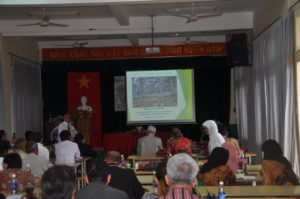 By all means, SEANAFE will always take part in any initiative that will come out of this International Agroforestry Congress. It will continue to promote regional collaboration towards advancing the science and practice of agroforestry in Southeast Asian region. Congratulations to all of us for making it to the 2nd International Agroforestry Congress!!! SEANAFE Chair
By all means, SEANAFE will always take part in any initiative that will come out of this International Agroforestry Congress. It will continue to promote regional collaboration towards advancing the science and practice of agroforestry in Southeast Asian region. Congratulations to all of us for making it to the 2nd International Agroforestry Congress!!! SEANAFE Chair
Download the: Book of Abstracts
Growth and Productivity of Teak Plantation in Daclac, Vietnam
Proceedings of the first national seminar on Teak planting in Vietnam. Buon Me Thuot, Dec. 2-3, 1995. Vietnam Forest Science and Technology Association.
Bao Huy Key Word: growth, productivity, Teak planting,
Citation: Huy., B. 1995. Growth and Productivity of Teak Plantation in Daclac, Vietnam. Proceedings of the first national seminar on Teak planting in Vietnam. Buon Me Thuot, Dec. 2-3, 1995. Vietnam Forest Science and Technology Association, pp 71-78.
